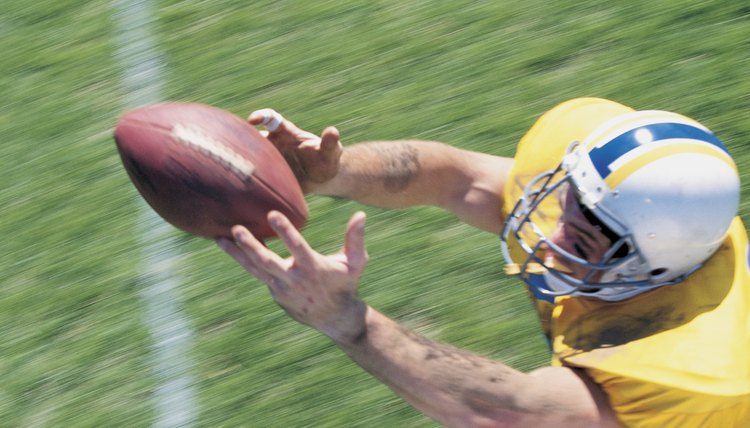What Are Three Good Positions in Football for Small Players?

While the common conception of football is that it's only for tall players, the fact is that the versatility of the game provides an avenue for athletes of all shapes and sizes to shine. Smaller players have three important positions in which they can excel, where elusiveness can more than make up for a lack of width or height. While there are a number of positions where smaller players can contribute, three such positions rise to the top of the list for importance to the execution of offense, defense and special teams.
What Is "Small"?
Small is, of course, a relative term. Depending on what level you intend to play, you may find that you're smaller than the average teammate in one group, and a powerhouse in another. In college and the professional ranks, 6-foot-2 is the average height, meaning half the players are taller and half are shorter. In high school, the averages are too variable to arrive at a definitive height range, because that age group experiences bursts of growth. However, anything shorter than 5-foot-8 is generally considered small. In general, if you are several inches shorter with a slighter build and less mass than other players on the field, you can group yourself in the “small” player segment. If you're an athlete with speed, agility or even relentless determination, a team can use those skills to outwit the opposing team in some particular phase of the game.
Smallest Players in the NFL
Here is a list of the smallest players in the NFL (starters). These are the starters of any position.
Player | Weight (lbs) | Height | Position | Team |
|---|---|---|---|---|
DeVonta Smith | 170.0 | 6' 0" | WR | Philadelphia Eagles |
Marquise Brown | 170.0 | 5' 9" | WR | Arizona Cardinals |
Josh Downs | 171.0 | 5' 9" | WR | Indianapolis Colts |
Zay Flowers | 172.0 | 5' 10" | WR | Baltimore Ravens |
Darnell Mooney | 173.0 | 5' 11" | WR | Chicago Bears |
Scotty Miller | 174.0 | 5' 9" | WR | Atlanta Falcons |
Greg Dortch | 175.0 | 5' 7" | WR | Arizona Cardinals |
Jordan Addison | 175.0 | 6' 0" | WR | Minnesota Vikings |
Rondale Moore | 180.0 | 5' 7" | WR | Arizona Cardinals |
Rashid Shaheed | 180.0 | 6' 0" | WR | New Orleans Saints |
Here is a list of the shortest players in the NFL (starters).
Player | Weight (lbs) | Height | Position | Team |
|---|---|---|---|---|
Greg Dortch | 175.0 | 5' 7" | Wide Receiver | Arizona Cardinals |
Rondale Moore | 180.0 | 5' 7" | Wide Receiver | Arizona Cardinals |
Marquise Brown | 170.0 | 5' 9" | Wide Receiver | Arizona Cardinals |
Josh Downs | 171.0 | 5' 9" | Wide Receiver | Indianapolis Colts |
D'Andre Swift | 208.0 | 5' 9" | Running Back | Philadelphia Eagles |
Kenneth Walker III | 211.0 | 5' 9" | Running Back | Seattle Seahawks |
Scotty Miller | 174.0 | 5' 9" | Wide Receiver | Atlanta Falcons |
Jahmyr Gibbs | 200.0 | 5' 9" | Running Back | Detroit Lions |
Aaron Jones | 208.0 | 5' 9" | Running Back | Green Bay Packers |
Hunter Renfrow | 185.0 | 5' 10" | Wide Receiver | Las Vegas Raiders |
Safety
The position of safety is the last line of defense for a football team. When the defense is on the field, a two-safety tandem will often play well back from the line of scrimmage, and their responsibility is to contain offensive players if they have pushed past all other defenders, if the offense is throwing a deep pass, or if the offense needs to use a safety blitz to attack the line of scrimmage. The position requires speed rather than size, and a small player with quick feet can cut the opponent's progress before it reaches the end zone.
Punt Returner
Another position where speed and elusiveness is more important than mass and strength is punt returner. The punt returner plays on a team's special teams unit. The special teams unit handles what's considered as transition plays, such as kickoffs and punt returns. Basically, whenever the ball changes possession from one team to the other, barring an in-play turnover, a special teams unit handles the transition. The position requires the punt returner to field a punted ball cleanly, evade the first wave of the opponent's coverage, then work upfield to gain as many positive yards as possible. Speed, elusiveness and low center of gravity are extremely helpful in evading the opponent's coverage and in fighting for extra yardage after the catch.
Running Back
In many offensive systems, a running back can succeed as long long as that player can find gaps, maintain balance, outrun defenders and remain hidden. A small player can excel in the roll of running back, because defenders often lose sight of the smaller player when he is hidden behind his own large offensive linemen. Combine this with an increased chance of pushing through the holes between defensive linemen since the smaller player often will make contact below the shoulders, smaller players can gain significant yardage past the line of scrimmage in the right offensive system.
References
Writer Bio
Bobby R. Goldsmith is a writer and editor with over 12 years of experience in journalism, marketing and academics. His work has been published by the Santa Fe Writers Project, "DASH Literary Journal," the "Inland Valley Daily Bulletin" and WiseGEEK.
